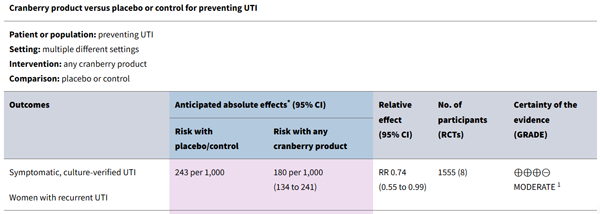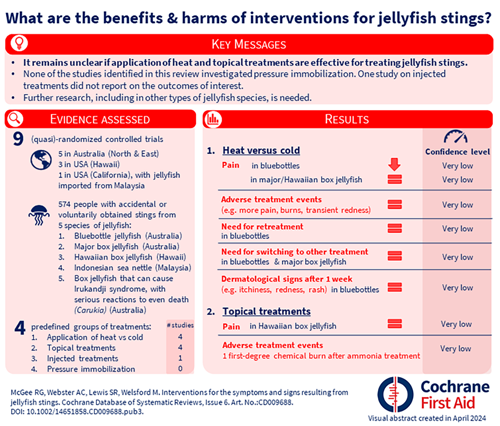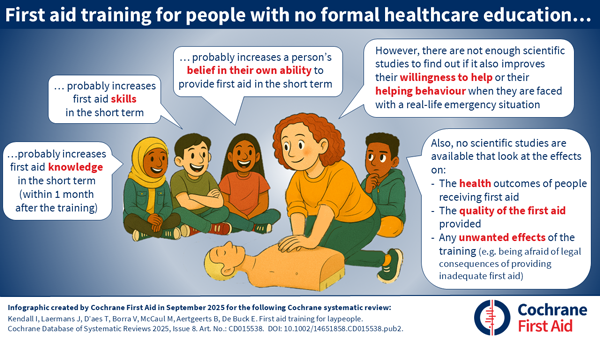Making evidence accessible, understandable and actionable: Cochrane First Aid’s approach
Cochrane First Aid (CFA) is a global, independent network of people that advocate the development, dissemination and uptake of high-quality research evidence on first aid. The initiative was launched in 2019 and is hosted by the Centre for Evidence-Based Practice (CEBaP) of Belgian Red Cross-Flanders. At CFA, we aspire to:
- Lower the bar towards the use of evidence for all those interested in first aid;
- Be the go-to resource for high-quality first aid-related systematic reviews; and
- Link the major evidence-synthesizing organisation, Cochrane, to the major players in first aid practice.
CFA is also part of a broader Cochrane Thematic Group on Acute and Emergency Care.
One of our main activities is to disseminate first aid evidence provided by Cochrane systematic reviews. In doing so, we target multiple audiences: first aid guideline developers, first aid trainers and the general lay public who provide/receive first aid. In this blog, we share our approach on how we use various dissemination formats in different languages and use multiple communication channels to get our messages across and how this contributes to the implementation of Cochrane evidence in first aid guidelines and practice globally.
The challenges we face
1. Formulating clear but scientifically correct messages
As in each form of science communication, it is challenging to present scientific information in a way that is both accurate and accessible to your target audience, while also acknowledging the complexities and uncertainties inherent to scientific research.
2. Reaching multiple target audiences, including the general public
It requires more effort than just having one target audience. In addition, reaching the general public is not straightforward, because they are not necessarily actively seeking information.
The search for solutions
1. Formulating clear but scientifically correct messages
Luckily, we are definitely not the first or the only ones facing this challenge. For over a decade, the GRADE Working Group developed and refined an approach to improve the clarity of communication of systematic review findings, to facilitate decision-making in health and education. Their narrative statements1 are standardiszed phrases used to communicate the certainty of evidence (i.e. how confident are we in the findings?) and the magnitude of effects in systematic reviews. They are designed to be clear, concise and consistent, ensuring that the findings are interpreted and communicated effectively to various audiences, including healthcare professionals, patients and the public.
At CFA, we love and apply this approach continuously, regardless of the target audience that we are trying to reach, because of its clarity. As an example, here is an excerpt from the findings of a Cochrane systematic review on the use of cranberry products (juice, tablets or powder) for preventing urinary tract infections (UTI):

The corresponding GRADE narrative statement is the following:
‘Cranberry products probably reduce the risk of symptomatic UTI in women with recurrent UTI’. The word ‘probably’ reflects the moderate level of certainty, indicating that we are moderately confident that the findings are close to the true effect of cranberries on UTI. Note that if the certainty level had been low, we would have concluded that: ‘Cranberry products may reduce the risk…’.
2. Reaching multiple target audiences, including the general public
The evidence community realises the importance of communicating clearly, succinctly and using jargon-free language in order to bridge the gap between research and the wider world. Therefore, scientific journals and organisations are increasingly asking researchers to write plain language summaries, make visual abstracts, create podcasts or vlogs, etc. Multiple resources providing guidance on these formats are available online.
With the help of several knowledge brokers and communications specialists, Cochrane itself has created multiple resources and even an online course on Dissemination Essentials.2 The course consists of six modules that includes ‘considering and involving your target audience(s)’ and ‘connecting with people’. While following this online interactive course, we were able to exchange ideas on how to reach multiple target audiences and how to involve them in deciding which formats to make.
Our communication and dissemination approach
In this part of the blog, we show how both of these solutions have shaped our approach to communicating and disseminating first aid Cochrane evidence. We highlight three aspects we focus on to target multiple target audiences and improve implementation, all while using clear scientifically correct messages.
1. Tailoring formats to our audiences’ needs and preferences
At CFA, we use a wide range of formats to disseminate the findings of first aid-related Cochrane reviews.
Interestingly, even among the same target audience, preferences regarding formats vary. In a small-scale survey of first aid volunteers of Belgian Red Cross-Flanders, some people indicated that they like single-image products, whereas others indicated that they would like more elaborate information. Therefore, we try to offer a range of different products.
Here are some examples of the products we make:
A blogshot is a one-page summary of the results of a Cochrane review using the wording of the GRADE narrative statements. It is a very popular format designed by Cochrane in collaboration with knowledge brokers from the UK.3 Blogshots are useful to share on social media, because they give a snapshot of the results and try to entice the reader to find out more. However, because of the large volume of text, they can be less attractive to the general public.
A visual abstract is a type of infographic that aims to present the findings of a Cochrane review in a concise and visually engaging way. Like the blogshot, they entice the reader to delve deeper into the review, but do so in a manner that is more appealing to lay audiences. We are one of the first and only Cochrane groups to use this format. Because there is less text, we are usually able to pack more information into the visual compared to a blogshot.

Simpler infographics. This is a type of visual that we have only recently started making for reviews that are of interest to the general public. The aim is to present the key findings of a Cochrane review, preferably using a single image.

2. Breaking down language barriers
We work together with an enthusiastic group of volunteers and with Cochrane Groups worldwide to translate our products. As one of our volunteers, Luis Fontes, rightfully mentions: ‘Unfortunately, language is still a barrier to dissemination and implementation of high-quality evidence to health care. Translation of Cochrane content is of paramount importance to achieve better and well-informed decision-making.’ Thanks to Luis and others, we are able to break down language barriers in the dissemination of Cochrane evidence. So far, our blogshots are available in 13 languages and our visual abstracts are available in English, Spanish and Italian. All are available on our website.
3. Using different platforms and partnerships to reach diverse audiences
We communicate through different social media platforms (X, Facebook, Instagram and LinkedIn) and quarterly newsletters. We also write Cochrane Corners, accompanied by visual abstracts, for publication in the International Journal of First Aid Education. These Cochrane Corners are meant to give first aid trainers, laypeople providing first aid and guideline developers direct access to highly relevant first aid-related evidence tailored to them, which they might otherwise not have access to. They are always accompanied by a commentary/response by a first aid practitioner.
In addition, we have an ongoing agreement with the consumer magazine, Testaankoop Gezond, that we previously highlighted in our blog for the 2022 campaign of World EBHC Day.4 By providing synthesised Cochrane evidence to the journalists of the magazine, we are able to reach 197,000 lay subscribers who are interested in health and nutrition. Despite our efforts, the general public remains the most difficult one to reach.
Another collaboration highlighted in our 2022 blog is that with the Global First Aid Reference Centre of the International Federation of Red Cross and Red Crescent Societies (IFRC). It allows us to use their communication channels to reach 192 national societies, many of which provide first aid training.
CFA is also part of different international first aid guideline writing groups, including those of the IFRC and the European Resuscitation Council. This way, we make sure to communicate the Cochrane evidence directly to the guideline developers, to ensure implementation into first aid practice.
Make sure to have a look at our website, where we compiled a list of basic resources on science communication and understanding research.
Key take-home messages
1. You don’t always need to reinvent the wheel. Search for existing solutions online, or reach out to people or organisations that are facing similar challenges. You’ll be astonished how much you can learn from each other.
2. Don’t be afraid to try out new things. What’s the worst that could happen?
3. Invest in relevant and sustainable partnerships to maximise your reach.
References
1. Schünemann HJ, Vist GE, Higgins JPT, Santesso N, Deeks JJ, Glasziou P, Akl EA, Guyatt GH. Chapter 15: Interpreting results and drawing conclusions [last updated August 2023]. In: Higgins JPT, Thomas J, Chandler J, Cumpston M, Li T, Page MJ, Welch VA (editors). Cochrane Handbook for Systematic Reviews of Interventions version 6.5. Cochrane, 2024. Available from https://www.cochrane.org/authors/handbooks-and-manuals/handbook/current/chapter-15#section-15-6-4.
2. Cochrane Training. Dissemination Essentials course materials [internet]. Available from: https://training.cochrane.org/online-learning/knowledge-translation/how-share-cochrane-evidence/dissemination-essentials-course
3. Cochrane Training. Blogshots [internet]. Available from: https://training.cochrane.org/online-learning/knowledge-translation/how-share-cochrane-evidence/choose-right-dissemination-produ-5
4. Laermans J. Cochrane First Aid: Using partnerships to reach practitioners and laypeople. [Blog]. Available from: https://worldebhcday.org/blog/2022/cochrane-first-aid-using-partnerships-reach-practitioners-and-laypeople
To link to this article - DOI: https://doi.org/10.70253/TEPA8750
Links to additional resources
https://firstaid.cochrane.org
https://www.cebap.org
https://www.cochrane.org/about-us/who-we-are/our-groups/acute-and-emergency-care
Disclaimer
The views expressed in this World EBHC Day Blog, as well as any errors or omissions, are the sole responsibility of the author and do not represent the views of the World EBHC Day Steering Committee, Official Partners or Sponsors; nor does it imply endorsement by the aforementioned parties.
